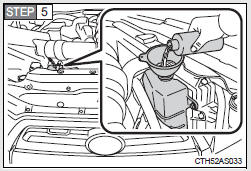Toyota 4Runner: If your vehicle overheats
If your engine overheats:
 Stop the vehicle in a safe place
Stop the vehicle in a safe place
and turn off the air conditioning system.
 Check to see if steam is coming
Check to see if steam is coming
out from under the hood.
If you see steam:
Stop the engine. Carefully lift the hood after the steam subsides and then restart the engine.
If you do not see steam:
Leave the engine running and carefully lift the hood.
 Check to see if the cooling fan
Check to see if the cooling fan
is operating.
If the fan is operating:
Wait until the temperature of the engine (shown on the instrument panel) begins to fall and then stop the engine.
If the fan is not operating:
Stop the engine immediately and call your Toyota dealer.

After the engine has cooled down sufficiently, check the engine coolant level and inspect the radiator core (radiator) for any leaks.
If the engine compartment cover needs to be removed.

Add engine coolant if necessary.
Water can be used in an emergency if engine coolant is unavailable.
Have the vehicle inspected at the nearest Toyota dealer as soon as possible.
Overheating
If you observe the following, your vehicle may be overheating:
• The engine coolant temperature gauge enters the red zone or a loss of power is experienced.
• Steam comes out from under the hood.
CAUTION
To prevent an accident or injury when inspecting under the hood of your vehicle
• If steam is seen coming from under the hood, do not open the hood until the steam has subsided. The engine compartment may be very hot, causing serious injuries such as burns.
• Keep hands and clothing away from the fan and drive belt while the engine is running.
• Do not loosen the radiator cap, or coolant reservoir cap while the engine and
radiator are hot.
Serious injury, such as burns, may result from hot coolant and steam released under pressure.
NOTICE
When adding engine coolant
Wait until the engine has cooled down before adding engine coolant.
When adding coolant, do so slowly. Adding cool coolant to a hot engine too quickly can cause damage to the engine.
 If the vehicle battery is discharged
If the vehicle battery is discharged
The following procedures may be used to start the engine if the vehicle's
battery is discharged.
You can also call your Toyota dealer or a qualified repair shop.
If you have a set of jumper (o ...
 If the vehicle becomes stuck
If the vehicle becomes stuck
Carry out the following procedures if the tires spin or the vehicle
becomes stuck in mud, dirt or snow:
Stop the engine. Set the parking
brake and shift the shift lever to P.
Remove the mud, s ...
Other materials about Toyota 4Runner:
Data List / Active Test
DATA LIST / ACTIVE TEST
1. READ DATA LIST
HINT:
Using the Techstream to read the Data List allows the values or states of switches,
sensors, actuators and other items to be read without removing any parts. This non-intrusive
inspection can be very usefu ...
System Description
SYSTEM DESCRIPTION
1. GENERAL
(a) When the ultrasonic sensors detect any obstacles at the corners and rear
of the vehicle, the system informs the driver of the distance between the sensors
and the obstacles by sounding a buzzer.
2. FUNCTION OF COMPONENT ...
0.0087
